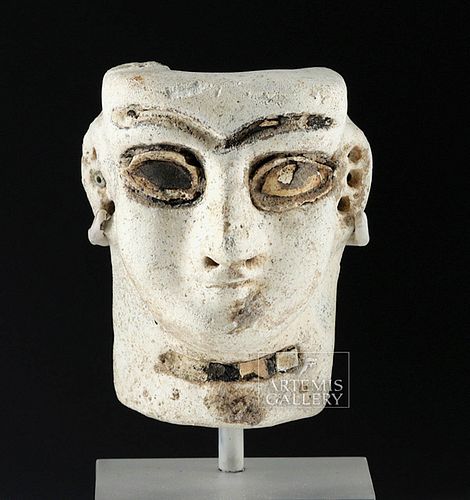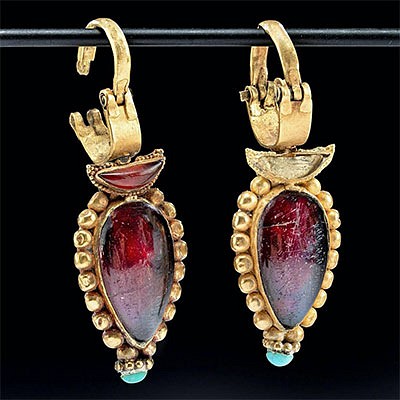Published Mesopotamian Glazed Head - Gypsum & Bitumen
Lot 86
About Seller
Artemis Fine Arts
686 S Taylor Ave, Ste 106
Louisville, CO 80027
United States
Selling antiquities, ancient and ethnographic art online since 1993, Artemis Gallery specializes in Classical Antiquities (Egyptian, Greek, Roman, Near Eastern), Asian, Pre-Columbian, African / Tribal / Oceanographic art. Our extensive inventory includes pottery, stone, metal, wood, glass and textil...Read more
Estimate:
$6,500 - $9,750
Absentee vs Live bid
Two ways to bid:
- Leave a max absentee bid and the platform will bid on your behalf up to your maximum bid during the live auction.
- Bid live during the auction and your bids will be submitted real-time to the auctioneer.
Bid Increments
| Price | Bid Increment |
|---|---|
| $0 | $25 |
| $300 | $50 |
| $1,000 | $100 |
| $2,000 | $250 |
| $5,000 | $500 |
| $10,000 | $1,000 |
| $20,000 | $2,500 |
| $50,000 | $5,000 |
| $100,000 | $10,000 |
| $200,000 | $20,000 |
About Auction
By Artemis Fine Arts
Nov 11, 2021
Set Reminder
2021-11-11 12:00:00
2021-11-11 12:00:00
America/New_York
Bidsquare
Bidsquare : It's a Small World | Diminutive Artifacts
https://www.bidsquare.com/auctions/artemis-gallery/its-a-small-world-diminutive-artifacts-7836
Join us for a very special auction featuring art & artifacts from East to West, North to South, and everywhere in between - with one small thing in common - size! Everything in this auction is approximately 6 inches or less - perfect for that last bit of shelf space in your curio cabinet! Artemis Fine Arts info@artemisfinearts.com
Join us for a very special auction featuring art & artifacts from East to West, North to South, and everywhere in between - with one small thing in common - size! Everything in this auction is approximately 6 inches or less - perfect for that last bit of shelf space in your curio cabinet! Artemis Fine Arts info@artemisfinearts.com
- Lot Description
Ancient Near East, Mesopotamia, Kassite period, ca. 14th to 13th century BCE. Staring past the confine of time, a head depicting a haunting guise carved in soft white glazed gypsum with a petite nose and mouth that appears secondary to the large almond-shaped eyes. The hollow eyes, arching eyebrows, and grooved neck are all inlaid with chalky-white shell fragments, each component held in place with thin layers of jet-black bitumen. Each ear sports three perforations with one being filled with a miniscule ear spool. Someone likely sculpted this figure for religious reasons; the figures with large eyes would have been placed in temples atop ziggurats. The striking eyes are a dominant feature of this kind of sculpture, likely representing a state of ecstatic prayer, and would have contributed to the sanctity of the temple. Custom lucite display stand included. Size: 1.75" W x 2.125" H (4.4 cm x 5.4 cm); 3.5" H (8.9 cm) on included custom stand.
While the ancient Egyptians popularized the use of faience in their artistic creations, it was in fact the ancient Mesopotamians that created the substance. Faience and its wide use in ancient art was invented during the Ubaid period of early Mesopotamia (ca. 6000 to 3800 BCE) and was employed to fashion countless types of items including dishes and vessels, molded figures, and others. Tiles made of faience were used to line the walls of some architectural buildings and were painted with vibrant and expertly-designed embellishments. Over time, the ancient Mesopotamians developed religious and spiritual uses for faience, creating abstract anthropomorphic and zoomorphic representations of deities and other religious imagery to use for votive offerings and temple decorations.
Throughout much of the second millennium, faience expanded to be used for wearable jewelry, pendants, and smaller decorations made to resemble stylized anthropomorphic figures. However, according to Scottish Archaeologist Jane McIntosh, PhD, “pendants in the form of women’s faces, inlaid with bitumen or pieces of colored faience set in bitumen…were also popular throughout Mesopotamia” (McIntosh, Jane. Ancient Mesopotamia: New Perspectives. ABC-CLIO, 2005, p. 254). Though the popularization and perfection of faience may have proliferated throughout the time of Egyptian Dynasticism, it was the Mesopotamians who began utilizing such substances to create truly spectacular works of art.
Published in "Beloved by Time: Four Millennia of Ancient Art." Fortuna Fine Arts, Ltd., New York, 2000, p. 10, fig. 4.
For a strikingly similar example, please see The Metropolitan Museum of Art, accession number 32.37: https://www.metmuseum.org/art/collection/search/322601
For another very similar example, please see The British Museum, object reference number 1927,0527.224: https://www.britishmuseum.org/research/collection_online/collection_object_details.aspx?objectId=369388&partId=1&images=true
Provenance: East Coast collection, New York Gallery, New York City, New York, USA, acquired before 2010; Published in "Beloved by Time: Four Millennia of Ancient Art." Fortuna Fine Arts, Ltd., New York, 2000
All items legal to buy/sell under U.S. Statute covering cultural patrimony Code 2600, CHAPTER 14, and are guaranteed to be as described or your money back.
A Certificate of Authenticity will accompany all winning bids.
PLEASE NOTE: Due to recent increases of shipments being seized by Australian & German customs (even for items with pre-UNESCO provenance), we will no longer ship most antiquities and ancient Chinese art to Australia & Germany. For categories of items that are acceptable to ship to Australia or Germany, please contact us directly or work with your local customs brokerage firm.
Display stands not described as included/custom in the item description are for photography purposes only and will not be included with the item upon shipping.
#133243Surface wear and abrasions commensurate with age as expected, small chips to brow, neckline, nose, and verso, losses to shell and bitumen inlays on eyebrows, eyes, and neck, with minor encrustations, and light discoloration. Smooth feel and bubbled verso likely a result of being exposed to elevated temperatures. Light earthen and mineral deposits throughout.Condition
- Shipping Info
-
All shipping is handled in-house for your convenience. Your invoice from Artemis Gallery will include shipping calculation instructions. If in doubt, please inquire BEFORE bidding for estimated shipping costs for individual items.
-
- Buyer's Premium



 EUR
EUR CAD
CAD AUD
AUD GBP
GBP MXN
MXN HKD
HKD CNY
CNY MYR
MYR SEK
SEK SGD
SGD CHF
CHF THB
THB
















